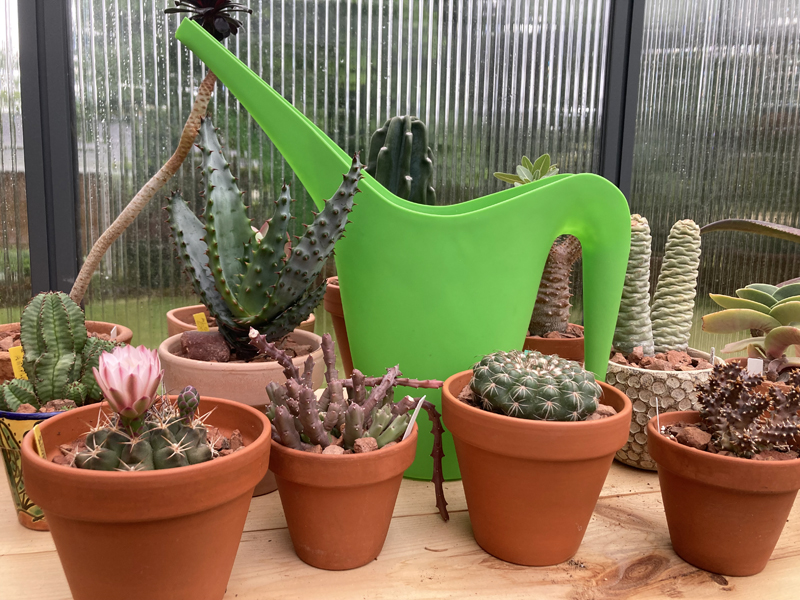
The most common question I get from people new to caring for cacti and other succulents is when to water (and when not to water!) Unfortunately, there are no hard and fast rules since the environment where you keep your succulent, whether outdoors or indoors, plays a large role.
The good news is there are some basic guidelines.
There are exceptions to the below guidelines – a few succulents are even winter growers, which affects their watering schedule! So, read up on your specific kind of plant to be safe.
- The goal is to mimic your plant’s natural environment as much as possible. This can be difficult, especially in our Canadian climate. But, with a bit of attention, it can be approximated enough so that your plant can be happy, and even thrive.
- Succulents have evolved to take in water quickly in between dry spells, so they don’t like to have wet roots for a long time. Therefore, it’s important to have well-draining soil and a drainage hole(s) in your pot. This way, the roots will not remain water-logged, which can cause rot.
- How to water: when watering, water thoroughly enough that water comes out the bottom drainage hole of the pot. Some people water from the bottom, sitting their plants in a tray of water until the soil saturates all the way to the top. I feel this is not necessary, or even preferable. By watering from the top, the water will help flush out salts and minerals which can build up and damage your plant over time. It’s also a lot quicker than watering all your plants from the bottom. Besides, in nature, rain falls from the sky and enters the soil from “the top”, and that seems to work fine…
- How can you tell for sure if your plant needs watering? Get used to how heavy your plant in it’s pot feels like when it’s mostly dry and when it’s just been watered. With a little practice, you’ll be able to pick up the pot and know right away.
Another option is to use a moisture meter – these are long metal “sticks” with a small gauge on the top telling you how wet the soil at the bottom of your pot is when you poke it in. You can find them pretty easily at garden centers or big box stores. However, these can damage the roots of your plant – especially the more delicate roots of succulents, and especially if used in smaller pots. So, use with caution if using a moisture meter. - When and how much to water:
From late spring to early fall, most succulents prefer more water than in winter, when they will be fully or partly dormant. Picture it like this: if you were asleep and somebody suddenly poured water on you, you wouldn’t be too happy, would you?
If the plant is inside all the time, I water every one to two weeks from spring to fall when there’s more light (especially if the plant is on a windowsill) and once every two to three weeks in winter. But, if the plant’s soil is still wet, I will wait until it dries out some more. Jungle cacti, such as “fishbone” or “zig-zag” cactus, are an exception. They like humidity all year (misting is good) and more regular watering (still, be careful not to waterlog them).
If the plant is outside in summer, water will evaporate and transpire faster from the soil, so more watering may be required. I recommend not leaving succulents out in heavy/prolonged rain events. Under some kind of shelter, even if just temporarily a patio table, is helpful. - Two more rules of thumb:
1. Warm temperatures and regular watering = okay.
Cold temperatures and wet = bad.
2. If you’re ever not sure if you should water your succulent yet – in other words, if you aren’t sure if it’s been long enough since the last watering, it’s best to ere on the side of dryness and not water yet unless the plant is looking severely dehydrated. Don’t confuse rot with dehydration! - Water Acidity vs. Alkalinity: This is not required, but -depending how serious you wish to be in your succulent care – many succulent growers swear by increasing the pH (acidity) of the water they use. Rainwater has a higher acidity (pH) level than the average city water supply’s pH. Plants absorb nutrients more efficiently with slightly acidic water. Yet, most tap water is very alkaline (the opposite of acidic), largely because this causes less long-term damage to city plumbing than acidic water with a higher pH.
It’s easy to increase the pH of tap water by adding a small amount of white vinegar to the water you water your plants with. The amount of vinegar depends on the amount of water in your watering container. You will need a pH meter (these can be purchased relatively inexpensively) or pH paper strip test kit. Check the pH of your tap water and then add a small amount (start with a teaspoon or less) of vinegar, stir, and test again. The goal is to get the pH to between 5.5 and 6.5 for optimal plant usage. Where I live, the water is about 8.5 on the acid/alkaline scale, so I have to add a teaspoon or so of vinegar to my watering can to bring it to about 6.5 – a lower number, but a higher pH.
